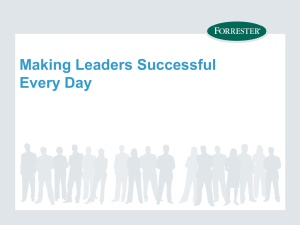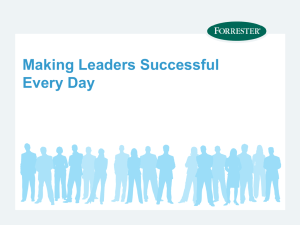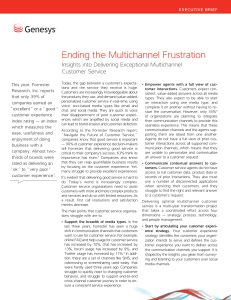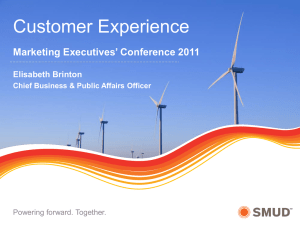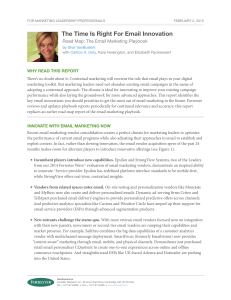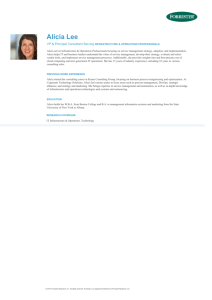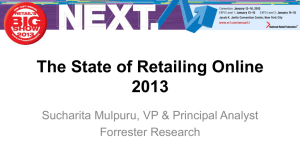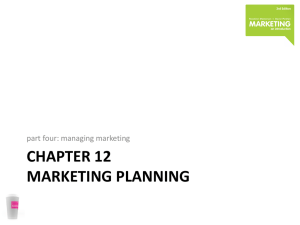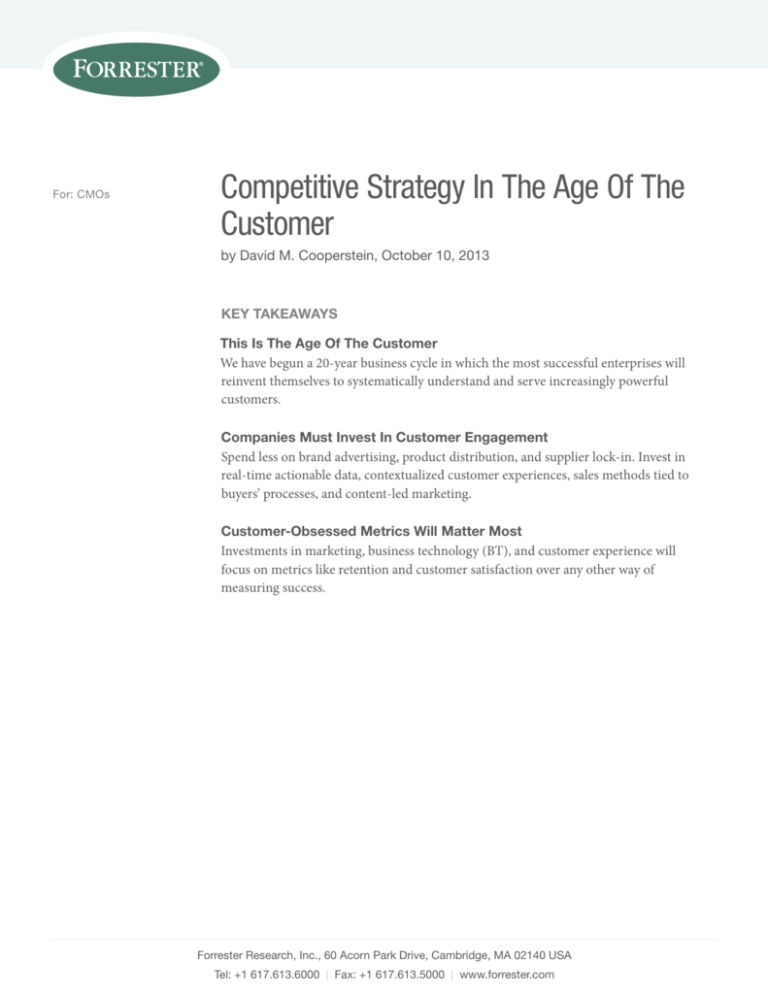
For: CMOs
Competitive Strategy In The Age Of The
Customer
by David M. Cooperstein, October 10, 2013
Key Takeaways
This Is The Age Of The Customer
We have begun a 20-year business cycle in which the most successful enterprises will
reinvent themselves to systematically understand and serve increasingly powerful
customers.
Companies Must Invest In Customer Engagement
Spend less on brand advertising, product distribution, and supplier lock-in. Invest in
real-time actionable data, contextualized customer experiences, sales methods tied to
buyers’ processes, and content-led marketing.
Customer-Obsessed Metrics Will Matter Most
Investments in marketing, business technology (BT), and customer experience will
focus on metrics like retention and customer satisfaction over any other way of
measuring success.
Forrester Research, Inc., 60 Acorn Park Drive, Cambridge, MA 02140 USA
Tel: +1 617.613.6000 | Fax: +1 617.613.5000 | www.forrester.com
For CMOs
October 10, 2013
Competitive Strategy In The Age Of The
Customer
Only Customer-Obsessed Enterprises Can Survive Disruption
by David M. Cooperstein
with Josh Bernoff, Alexandra Hayes, and Elizabeth Ryckewaert
Why Read This Report
Empowered customers are disrupting every industry; competitive barriers like manufacturing strength,
distribution power, and information mastery no longer create competitive advantage. In this age of the
customer, the only sustainable competitive advantage is knowledge of and engagement with customers.
The successful companies will be customer-obsessed, like Amazon.com, Macy’s, and salesforce.com.
Executives who lead customer-obsessed enterprises must pull budget dollars from areas that traditionally
created dominance — brand advertising, distribution lockup, mergers for scale, and supplier relationships
— and invest in four priority areas: 1) real-time actionable data sharing; 2) contextualized customer
experiences across touchpoints; 3) sales efforts tied to buyers’ processes; and 4) content-led marketing and
customer interactions. Those who master the flow of relevant data and improve frontline customer staff
will have the edge. (Note: This report is an update of “Competitive Strategy In The Age Of The Customer,”
originally issued to clients on June 6, 2011.)
Table Of Contents
Notes & Resources
2 Disruption Is Upon Us
3 Welcome To The Age Of The Customer
Forrester interviewed 15 vendor and user
companies, including Bain, Bank of America,
Comcast, MePlusYou, and MTV Networks.
7 You Want To Compete? Get CustomerObsessed
Related Research Documents
8 Customer-Obsessed Enterprises Invest
Differently
WHAT IT MEANS
13 Customer-Obsessed Enterprises Will
Redefine Business Fundamentals
14 Supplemental Material
Technology Management In The Age Of The
Customer
October 10, 2013
Preparing For The Intelligent Enterprise: A
Blueprint For Market Insights Professionals
April 29, 2011
What People Really Need
February 4, 2010
© 2013, Forrester Research, Inc. All rights reserved. Unauthorized reproduction is strictly prohibited. Information is based on best available
resources. Opinions reflect judgment at the time and are subject to change. Forrester®, Technographics®, Forrester Wave, RoleView, TechRadar,
and Total Economic Impact are trademarks of Forrester Research, Inc. All other trademarks are the property of their respective companies. To
purchase reprints of this document, please email clientsupport@forrester.com. For additional information, go to www.forrester.com.
For CMOs
2
Competitive Strategy In The Age Of The Customer
Disruption is upon us
By 2011, it had become clear to us that digital disruption was on the doorstep of every major
industry, as startups and nimble competitors found ways to upend their businesses. If you’ve been
reading the news since then, you’ve seen some great examples:
■ Disruption has a new source of funding: interested individuals. On Indiegogo and
Kickstarter, 50,000 projects have raised just shy of $1 billion in funding for everything from
short-form content to custom-made bikes.
■ Ecosystems have shifted. Google and Microsoft now compete with Apple on full digital
ecosystems — hardware, devices, and cloud-based services. Who would have predicted that
each of them would buy hardware companies — Motorola and Nokia, respectively — to disrupt
their own software-only business models? After a decade when software trumped hardware,
they followed Apple’s strategy to own the end-to-end digital environment, hardware included.
■ Jeff Bezos buys a newspaper. The guy who reinvented retailing and media delivery now has his
sights set on news distribution with his acquisition of The Washington Post. Says the CEO of
Amazon.com about his plans, “We’ve had three big ideas at Amazon that we’ve stuck with for 18
years, and they’re the reason we’re successful: Put the customer first. Invent. And be patient. If
you replace ‘customer’ with ‘reader,’ that approach, that point of view, can be successful at the
Post, too.”1
■ Netflix wins an Emmy using consumer data. In 2011, Netflix was in turmoil due to a failed effort
to split its streaming service from its DVD-by-mail origins. Two years later, it was the first
nonnetwork to win an Emmy award for its critically acclaimed series House of Cards in the
category of best directing. How did it win? By using data collected over the years about people’s
viewing habits and selecting a theme, cast, and launch approach that Netflix scientifically predicted
would be a winner. Oh, and Netflix signed up another 2 million US and 3 million total subscribers
in the first quarter of 2013 alone, bringing their overall total to 30 million paying subscribers.
■ Wearables disrupt wearables. Nike built a business off of learning people’s running habits and
fitness through Nike+ and the FuelBand. Yet here comes the second generation already, led by
Samsung’s Galaxy Gear smart watch. And Apple’s iPhone 5s, with its motion-sensing M7 chip,
may make fitness devices like Fitbit or FuelBand obsolete.
■ Apps really do disrupt traditional business models. Nothing is more physical than losing
weight. But how you go about it is no longer the domain of Weight Watchers, which blamed
mobile fitness apps for two years of flat revenue.2 Who’s gaining on the weight loss company?
With eight people on staff, the LoseIt app has generated 14 million downloads and enabled the
loss of 19 million pounds.
© 2013, Forrester Research, Inc. Reproduction Prohibited
October 10, 2013
For CMOs
3
Competitive Strategy In The Age Of The Customer
Customer Power Drives This Disruption
Here’s one thing you can now count on: Technology-fueled customer-led disruption will continue to
arrive unexpectedly on your doorstep. Your customers want things faster, better, cheaper, and with
a higher degree of service; technology makes it possible for them to get what they want. Consumers
are exposed to a tremendous number of marketing messages — US consumers are exposed to
5.3 trillion ad impressions per year according to comScore.3 And there are now 6.8 billion mobile
subscriptions in place (compared with 7.1 billion people on the whole planet); connections to
people and information through mobile devices have become ubiquitous.4
Welcome to the age of the customer
Things are different now; we’ve entered a new era that Forrester calls the age of the customer. We
define the age of the customer as:
A 20-year business cycle in which the most successful enterprises will reinvent themselves to
systematically understand and serve increasingly powerful customers.
While companies have always, to a greater or lesser extent, called themselves “customer-centric,” this
is different. This is not about “customer-centric” thinking or “the customer is always right.” Instead,
the new power of customers means that a focus on the customer now matters more than any other
strategic imperative. Looking at the frameworks companies have competed within over the past
century, you can see how the age of the customer is different (see Figure 1):
■ 1900 to 1960 was the age of manufacturing. In this era, if you owned the factory, you owned the
market. Factories were expensive to build but, once created, generated products at prices that
others couldn’t compete with. In the age of manufacturing, companies like Ford Motor (cars) and
RCA (color TVs) built up a lead with convenient, well-priced, mass-produced products.
■ 1960 to 1990 was the age of distribution. Two trends changed things in the 60s: Business
started globalizing, and in developed countries, retail moved with the population to the suburbs.
Deregulation and freer trade meant that companies could manufacture cheaply in Asia. In this
world, the key barrier to competition was a distribution network — one that brought supplies
from where they were cheapest into local retail stores where consumers, energized by mass
advertising, could buy these branded goods. Among the companies that took advantage of this
shift were Procter & Gamble, UPS, and Wal-Mart.
■ 1990 to 2010 was the age of information. Networked computers and information technology
helped companies master the information flow generated from real-time point-of-sale data to
fine-tune their strategies. They embraced global manufacturing supply chains and eventually
data-fueled eCommerce to extend that power. Companies with information-centric products
and services thrived, including software companies, cable and mobile operators, and financial
© 2013, Forrester Research, Inc. Reproduction Prohibited
October 10, 2013
For CMOs
4
Competitive Strategy In The Age Of The Customer
services providers. In hard-goods companies, computers ran billing, customer service, and the
product catalog; those that mastered the information flow outmaneuvered their competitors.
This information-powered world enabled the rise of companies like Amazon, Capital One,
Comcast, and Google.
■ 2010 and beyond will be the age of the customer. One by one, every corporate investment has
been commoditized. Now every company can tap into global factories and global supply chains.
After huge technology investments, companies are realizing that the Internet cloud provides
all of the computing resources they need, just as they need them. Manufacturing, distribution,
and IT-oriented technology management are all table stakes. The only source of competitive
advantage is the one that can survive technology-fueled disruption — an obsession with
understanding, connecting with, and serving customers. In this age, companies that thrive, like
Amazon (again), Macy’s, salesforce.com, and USAA, are those that shift their budgets, people,
and business structure toward customer knowledge, relationships, and actions. IT investments
will shift toward what we call business technology (BT) — technology, systems, and processes
designed to win, serve, and retain customers.5
Figure 1 We Have Entered The Age Of The Customer
1900
1960
1990
2010
Age of manufacturing Age of distribution
Age of information
Age of the customer
Mass manufacturing
makes industrial
powerhouses
successful
Connected PCs and
supply chains mean
those that control
information flow
dominate
• Amazon
• Google
• Comcast
• Capital One
Empowered buyers
demand a new level of
customer obsession
• Ford
• Boeing
• GE
• RCA
Global connections
and transportation
systems make
distribution key
• Wal-Mart
• Toyota
• P&G
• UPS
59159
Beyond
• Macy’s
• Salesforce.com
• USAA
• Amazon
Source: Forrester Research, Inc.
Revisiting Michael Porter: How Empowered Customers Upend Competitive Advantage
Competition looks different in the age of the customer. We analyzed the five forces that Michael
Porter cites in Competitive Strategy, which many view as the definitive guide to competitive strategy
(see Figure 2).6 Applying what we now know about empowered customers to the five forces model
adds new dimensions to the story.
© 2013, Forrester Research, Inc. Reproduction Prohibited
October 10, 2013
For CMOs
5
Competitive Strategy In The Age Of The Customer
■ Barriers to entry are lower. Empowered customers can easily find the cheapest prices from
suppliers, large or small, anywhere in the world. Global outsourcing erodes economies of scale,
online channels render distribution strength impotent, customer word of mouth undoes huge
brand investments, and networked consumers and entrepreneurs undermine copyrights and
patents. Startups have it even easier now that they can design products with 3D printers, power
their IT with Amazon Web Services, and outsource in one step with sites like made-in-china.
com. While any given startup has a low chance of success, the swarm of thousands of startups
with no barriers to entry threatens competitors in nearly every industry with a free-for-all.7
■ Substitute products and channels gut profits. Digital substitutes take existing ideas further:
Flipboard and Facebook undercut big media sites with alternative news distribution, Expedia
makes travel agents obsolete, iPads cause the laptop business to implode, and eBay and Amazon
swallow profits from the whole retail industry.8 Digital substitution is collapsing value chains
and erasing profits across multiple industries. The customer is at the center of this disruption,
because innovators targeting any business know that if you give her what she perceives as value,
she’ll gladly substitute your product for what she’s buying now.
■ Buyers have more power than ever. With online reviews and mobile web access, your customers
know more about your products, your service, your competitors, and pricing than you do.
Something as simple today as a multitab browser makes comparison-shopping trivially easy. As
Porter himself said: “Where the buyer has full information about demand, actual market prices,
and even supplier costs, this usually yields the buyer greater bargaining leverage.”9
■ Employees, a key element of supply, have power over companies. In a knowledge economy, a
key ingredient in any product is people. Individuals — whether it’s Oprah, a killer salesperson,
or your star software engineer — bring knowledge, ideas, and relationships that companies need
to remain competitive. And if they don’t get what they want, they can increasingly jump ship
and go work for the next guy.
■ Your competitors now have instant access to your tactics and strategies. Your own customers
are sharing their experiences online, search engines expose interest in keywords, and everything
your competition wants to know about you is on your website and those of your best influencers.
In short, customers practically serve granular insight about you to your competitors’ feet. This
amps up competition, since competitors can match or react to any move you make instantly.
© 2013, Forrester Research, Inc. Reproduction Prohibited
October 10, 2013
For CMOs
6
Competitive Strategy In The Age Of The Customer
Figure 2 Michael Porter’s Five Forces Revisited In The Age Of The Customer
Potential
entrants
Barriers to entry are
minimal:
Outsourced manufacturing
and digital connections
make new entry
easier
Industry
competitors
Competition is
fiercer:
Perfect real-time
information exists about
competitors’ pricing
and policies
Power of
buyers
Customer
Power of
suppliers
Technology empowers
buyers:
Digital tools make
buyers smarter
People are a key
supply element:
Employees carry ideas
with them
Threat of
substitutes
Digital disrupts
industries:
Digital products
supersede physical
offerings
59159
© 2013, Forrester Research, Inc. Reproduction Prohibited
Source: Forrester Research, Inc.
October 10, 2013
For CMOs
7
Competitive Strategy In The Age Of The Customer
You WANt to compete? get customer-obsessed
This analysis of Porter’s five forces reveals that building walls around your castle is no longer a
successful long-term strategy; customers, armed with technology, are now too powerful. The
only constant is the loyalty of satisfied customers. As marketing thinker Seth Godin said to us, “If
you have already announced that you are in a commodity business, you have given up. We don’t
need you or your salary, since you make a commodity.” Rob Markey, a Bain expert on sources of
corporate growth, says that in mature markets, sustainable organic growth comes only from the
loyalty of customers.
It’s no longer sufficient to say that you are simply “customer-centric” or “customer-focused.” The
only successful strategy in the age of the customer is to become customer-obsessed — to focus your
strategic decisions first and foremost on how your customers expect you to engage them. Here’s
what we mean:
A customer-obsessed enterprise focuses its strategy, its energy, and its budget on processes that
enhance knowledge of and engagement with customers and prioritizes these over maintaining
traditional competitive barriers.
Like all strategies, customer obsession is a choice, requiring not only a change in stance but also
a change in how money is spent as well as a commitment to valuing the customer embrace over
building barriers. These are the attributes of a customer-obsessed enterprise:
■ Nimble, emphasizing speed over strength. Customer-obsessed enterprises embrace
management structures that transform the enterprise from one of slow-moving silos into an agile
evolving organism that is able to adapt quickly to the needs of the ever-evolving customer. This
business agility doesn’t come easy, but it’s required in today’s customer-led world.10 Companies
that focus on BT that boosts customer relationships will be more agile or better positioned for
speed. According to an IBM study of CEO attitudes, CEOs in the most successful organizations
“recognize the value of nimble, agile enterprises that react well to, and even anticipate, the rapid
changes inherent in complex environments.”11 Speed matters too: When Toyota responded slowly
to the charges about defects in its accelerator pedals, automotive site Edmunds.com found that
consumer intent to purchase the company’s products dropped by almost 50%.12
■ Flexible, enabling customer preferences to prevail over one-size-fits-all. Lock-in mechanisms —
mobile phone contracts, proprietary technology, and frequent-flier programs, for example — don’t
create loyalty; they just create barriers to leaving. Forcing customers to comply with one set of
rules designed for the masses makes your offer a commodity over time. In the long run, you’ll be
able to move your Samsung Galaxy to another network, use Mint to manage all of your financial
relationships, and plant your body on a comfortable plane from Virgin Atlantic that makes you
forget your mileage balance. Customer-obsessed enterprises worry more about flexing to meet
customer needs and less about ways to block them from fleeing.
© 2013, Forrester Research, Inc. Reproduction Prohibited
October 10, 2013
For CMOs
8
Competitive Strategy In The Age Of The Customer
■ Global, balancing worldwide markets with local empathy. Your current and emerging
competitors are finding new markets. They’re obsessing about how to tap the 800 million new
middle-class customers, whom Goldman Sachs predicts will rise in Brazil, Russia, India, and
China, and are ready to make substantial brand investments in multiple categories. These
forces undermine companies that concentrate on sourcing and selling from a home-country
perspective only.
■ Connected, providing services that enhance the original product. The new consumer uses
channels — especially mobile channels — to seek information everywhere, instantly. She scans
the bar codes in your store and knows your competitors’ prices; he gets a flash message when his
favorite band is spotted in town. If your company is customer-obsessed, then every product and
service needs a halo of quickly updated information in the cloud as well as apps and pages to
deliver it in a customized way to smart devices wherever they may be.
Customer-obsessed enterprises invest differently
You’re not customer-obsessed unless you change how you budget. For example, one marketer told
us that when he worked with General Motors, “the joke was that low risk was building a $2 billion
plant.” (How did that work out?) Contrast that with the CEO who decided that rather than open 100
more stores, it would be more profitable to invest in technology and programs to increase loyalty to
and revenues from the stores the company already had. Customer-obsessed enterprises find ways to
sell more to current customers and to get them to advocate for them with their friends. According
to Bain, “If you are the loyalty leader, on average you will grow twice as fast as your market. Loyalty
leaders have a 15% cost advantage.”13 Want to get customer-obsessed? Keep these four priorities in
front of you as you budget (see Figure 3):
1.Invest in real-time data sharing for actionable customer intelligence.
2.Shift spending from general to contextualized customer experience.
3.Tie the selling effort to the buyer’s process.
4.Reallocate funds to support content creation over ad creative.
© 2013, Forrester Research, Inc. Reproduction Prohibited
October 10, 2013
For CMOs
9
Competitive Strategy In The Age Of The Customer
Figure 3 Strategic Budget Imperatives For Customer-Obsessed Enterprises
Spend more
Spend less
Invest in real-time data for
actionable customer
intelligence
· Integrating customer data
sources
· Building predictive algorithms
· Developing multidimensional
views of customers
· One-shot mailing list purchases
· Market research surveys and
small in-person focus groups
Shift spending from
general to contextualized
customer experiences
· Experience maps for
point-in-time relevance
· Touchpoint-specific behavior
analysis
· Personalization without
customer value
· Mass emails
· Inflexible content
management systems
· Persona creation
· Sales and service scripts
focused on customer value
· Post-sales engagement
· Knee-jerk collateral creation
· Short-term-focused
sales programs
· Content calendars aligned with
business priorities
· Journalists to tell the corporate
or brand story
· Shareable, trackable,
utility-focused content
· Mass advertising
· Single-channel-driven creative
· Reach- and impression-based
metrics
Tie the selling effort to the
buyer’s process
Reallocate funds to
support content creation
over ad creative
59159
Source: Forrester Research, Inc.
Invest In Real-Time Data Sharing For Actionable Customer Intelligence
Customer-obsessed enterprises take advantage of multiple sources of data about customers so that
they can respond in customer-friendly ways. With appropriate privacy safeguards, they also use this
customer intelligence to gain insight at scale that leads to better products over time. To make data
your ally as you prepare for the age of the customer, you should:
■ Blend internal and external data to create intelligence marketplaces. Firms as diverse as
energy companies, retailers, and financial firms have recognized that the power of data lies
not in what they hold close to the vest, but rather what happens when they make business
data available to partners, suppliers, or third parties.14 Lowe’s was able to improve its vendor
relationships and shopper success by blending data it had about sales in its stores with its
suppliers’ data about purchase patterns across chains. Result: The retailer and its suppliers were
able to address inventory glitches, improve their business relationship, and help shoppers get the
items they really need.
© 2013, Forrester Research, Inc. Reproduction Prohibited
October 10, 2013
For CMOs
10
Competitive Strategy In The Age Of The Customer
■ Create a multidimensional view of the customer to predict next actions. Firms that are
customer-obsessed need to know more than just historical data about their customers. They need
to expand their analysis to predict the next step that a customer may take, using that analysis to
inform pricing, product needs, messaging, and media buys.15 How can these predictive
capabilities make companies more customer-obsessed? They can use application programming
interfaces (APIs) to act on previously unavailable data, like input from the Nest thermostat, the
Propeller Health inhaler sensor, or Google’s Waze traffic app, providing customers with cost
savings, prescription fine-tuning, or alerts for the fastest route home, respectively.
■ Use data to save money or build new revenue streams. PG&E and Duke Energy both told
customers that if they save enough money with the utilities’ apps, they wouldn’t raise rates to
fund new power plants. Forbes and data owners like Expedia have generated revenues from
sales of aggregated data to trusted providers like BlueKai.16 Appropriately exploited, data can
both save money and generate revenues.
Shift Spending From General To Contextualized Customer Experience
How’s your service reputation? If you treat customer service as a cost center and customer experience
as marketing overlay, your reputation will suffer — and you will lose ground to the competition in
the age of the customer. According to Bain, a 5% increase in customer retention can generate a 75%
increase in profitability, and it costs six times more effort to get a customer than to keep one whom
you already have. More importantly, companies that lead in Forrester’s Customer Experience Index
(our survey-based measure of customer experience quality) show better stock market and revenue
performance than customer experience laggards.17 A customer-obsessed enterprise must increase
investments in customer experience and customer service to generate relationships and amplify fans.
■ Don’t just talk about customer experience; fund it. While 92% of companies we surveyed say
that customer experience is a top strategic priority, 45% say that they do not have the budget they
need to get the job done. Their budgets are not obsessed with customers. Customer-obsessed
enterprises invest in experience that spans all touchpoints — in person, on every device, and in
every channel the company uses. Best practice: Create a centralized team to spearhead this change,
and dedicate funds to improvements — and measurement — that can be applied to any channel.18
■ Put money behind customer experiences that recognize customers. With data at your
disposal, you can create experiences that go beyond just personal (“Welcome back Sam”) to
contextual (“Glad to see you back in Dallas on your mobile, Sam”). Experiences that tie the
customer’s profile, past engagement history, and current situation into contextually personalized
customer experiences ooze with relevance when done right. Google does this with its Gmail
ads and Google Now traffic advice. You can do this too with a mix of tools like marketing
automation from ExactTarget and Experian, Adobe’s site search tools, and recommendation
engines from RichRelevance or Monetate.19
© 2013, Forrester Research, Inc. Reproduction Prohibited
October 10, 2013
For CMOs
11
Competitive Strategy In The Age Of The Customer
■ Expect payback from experiences tailored to touchpoints. You need a deep understanding of
the value of channels, both independently and in concert. Our research shows that a focus on
the right experience in each touchpoint a consumer uses to research and buy a product has a
positive impact on price premium.20 In our analysis, we found that a high percentage of recent
buyers of cars and clothes paid a lot of attention to the retailer or manufacturer website and
email channels, making investments in those channels worthwhile. But travel buyers are not
swayed by anything other than price.
Tie The Selling Effort To The Buyer’s Process
Customer-unfriendly companies believe that the route to sales growth is to cold-call and email
customers until they submit to a purchase, regardless of the value or the timing of the sale and its
meaning to the buyer. As one senior marketer confided to us, most sales teams are “coin-operated” —
incented purely on getting the signature on the dotted line for a transaction. Putting the customer’s
decision journey front and center builds more empathy, makes sales more predictable, and creates
great loyalty in the long run. If you’ve got a large sales organization, shift budget to:
■ Recognize that the customer’s path-to-purchase is no longer a straight line. In the age of
the customer, buying patterns are not linear, as the distance between exposure and transaction
could be the distance between their eyes and their Target app. To master that route to the
customer, firms need to stimulate demand at the speed of light, using programmatic media
buying tools from SpotXchange or Tremor Video to place online video preroll ads on the spot
or via an agency trading desk like Omnicom’s Accuen or WPP’s Xaxis. These tools can finally
deliver the utopian “right message at the right time” across web, mobile, video, and, soon, digital
TV ad placements the millisecond that demand is identified.
■ Train sales teams on the “value of providing value” in B2B sales meetings. Sales teams are
often trained on the value proposition of their offering, but those statements are often divorced
from the real expectations and timing of value for the customer. Sales training (and incentive
structures) in the age of the customer must focus on the delivery of value in a meeting with
a prospect or client and on making clear what the buyer’s side of the value equation in a
conversation is going to look like.21
■ Create a customer connection post-transaction. Why did BMW give four years of free service to
its luxury carbuyers and lessors? These buyers could afford a BMW, so they could afford the $2,000
in oil changes and wiper blades. But BMW realized that if it directed customers to the dealership
for free service, they would get to know the staff and the quality of care. Over a four-year time
frame, new models would come out and new life stages would emerge. The single guy in a 3 Series
would be more apt to upgrade to the X5 when job, spouse, and kids required more space. This
policy also created better satisfaction with the vehicle when the service agreement ended.22
© 2013, Forrester Research, Inc. Reproduction Prohibited
October 10, 2013
For CMOs
12
Competitive Strategy In The Age Of The Customer
Reallocate Funds To Support Content Creation Over Ad Creative
Jeff Bezos says, “Brand is what people say about you when you leave the room.” These days, that
impression depends as much on experience and service as it does on advertising. Stop using ads to
cover up a weak reputation, unhappy customers, and strong competitors. Prioritize creating utility,
marketing with content, and generating word of mouth over mouthing off: Cut your media and
production budget by at least 10%, and spend the money on content and connections that have a
multiplier effect in social and mobile channels. Connect creative efforts to owned and earned media,
as ads are far more effective when customers are primed to believe them.
■ Don’t just embrace social applications; measure their impact across all customer
touchpoints. The customer-obsessed marketer stimulates and measures word of mouth, so she
can prove it’s working. Coca-Cola agrees that social may not directly drive sales, but it is critical
to the overall marketing effort.23 Any social effort should have the discipline to measure impacts
on reach, depth, and relationship metrics.24 And as brands like Glidden, Barclaycard, and Cisco
have found, a tight social connection not only amplifies fan activity but also generates learning
that leads to better products and easier marketing in the future.25
■ Delight customers with mobile devices that supply information constantly. Consumers
with smartphones assume that information that they need is always available on their device.26
A mobile application that’s finely tuned for moments of need — personalized, relevant, and
location-aware — demonstrates true customer obsession. For example, American Airlines’
mobile app helpfully shows the gate information about your upcoming flight and even pops
up a TSA-ready mobile boarding pass as you head to the security line. Sherwin-Williams’ app
matches colors from photos, helping draw in some female customers less comfortable with
hardware stores. The Philadelphia Eagles’ text-messaging system provides instant service to fans
having problems during a game.
■ Be generous with content. Generous brands are those that give customers things they want
along with, or even before, a purchase. According to content marketing platform Skyword,
content for content marketing needs to be “searchable, snackable, and sharable.”27 Think
of the content created by Adidas for coaches to assess their players’ performance, L’Oréal’s
Destination Beauty site on YouTube, or the extensive blogs and white papers IBM uses to read
the elusive midsize enterprise market. Generosity with content drives a lot of inbound interest
in companies’ sites and social presences, far more cheaply than advertising. Reduce spending on
print ads in favor of content and experiences that will resonate with the brand.28
© 2013, Forrester Research, Inc. Reproduction Prohibited
October 10, 2013
For CMOs
13
Competitive Strategy In The Age Of The Customer
W h at I t M e a n s
Customer-obsessed enterprises will redefine business fundamentals
The budgeting changes necessary in a customer-obsessed enterprise will ripple throughout the
organization, from technology departments to media buyers. Business models and success metrics
will change in this new world.
■ Customer experience will subsume marketing. The tension that is building between
marketing and customer experience will result in a winner — customer experience.
Marketing is an important process but will have to take orders from the customer experience
(CX) leaders to do the job right in a customer-obsessed world. CMOs who get it will take
over the CX role and lead brand and CX together, but those who don’t will have a new boss
to answer to.
■ Utility will define brand success. In the Mad Men era, brand awareness, sales lift, and
sentiment were metrics that validated the success of a campaign. But in the age of the
customer, “share of digital interactions” will be more important to brand owners trying to
build a bridge to their customers. Brands will go beyond the emotional connection to build
content, apps, and social tools that drive attention and sales. Early leaders here include
Dollar Shave Club, which has created the right tone to compete with the giant Gillette with a
quirky approach to men’s toiletries, and Whole Foods, which brings content and community
to its highly successful premium-priced grocery store.
■ Impression-based media revenue will suffer. Broad-reach advertising, long the connecting
point between advertisers and buyers, will be hit hard by the age of the consumer. Why?
Because customer-obsessed enterprises will find that relevant targeted marketing will turn in
more profitable results and that reach-based media plans will suffer a lack of effectiveness as
digital media deepens its hold. The answer for media companies: programmatic targeting of
ad placements in both online and new digital TV formats. Print will be left behind.
■ Companies will shift from focusing on acquisition to obsessing about lost customers.
Celebrating new wins, whether by revenue or by landed account, are always occasions to
break out the bubbly. But customer-obsessed enterprises will balance the praise with the
reality check of renewal by segment or account. Metrics like “nonpurchasers within 90 days”
for consumer packaged goods brands or “lease nonrenewals” for auto companies will help
enterprises understand where they are missing the mark. The impact: faster innovation
drawn from the lessons learned from lost accounts and declining consumer segments, with
rewards for those that minimize customer defections.
© 2013, Forrester Research, Inc. Reproduction Prohibited
October 10, 2013
For CMOs
14
Competitive Strategy In The Age Of The Customer
■ Mutualized companies will come back into vogue. Publicly traded companies can make
their managers wealthy but may prevent companies from doing what is right for the
customer. Rare are the CEOs like Jeff Bezos who are willing to invest long-term in customer
relationships over immediate profits. We predict that customer-owned companies like
Vanguard and USAA will continue to rise and gain share in the age of the customer because
they are able to hit their financial targets by serving their customers better.
■ The subscription economy will rise. Services like Lyft and AirBnB are all the rage as people
shift from owning things to sharing them enabled by easy access to inventory. Next on the
horizon, and particularly from customer-obsessed enterprises, will be the growth of the
subscription economy, defined by people paying upfront for discounts on things they would
normally buy one at a time. Know you’ll spend at least 20 nights on the road next year? Buy
your rooms from Starwood properties in January, and use them in the properties you like
at a predefined rate. Amazon already offers 10% to 15% off of razors, vitamins, and other
replenishment items if you agree to have them delivered on a routine basis.
■ Customer-obsessed strategies will redirect technology spending. Companies have
historically pursued cost savings to justify spending on technology hardware, software, and
services. In the age of the customer, customer-obsessed enterprises will justify technology
expenditures through improvements in customer experience and revenue growth. The
resulting BT agenda will employ new metrics like “customers created per BT dollars spent”
to sustain focus on the company’s customer goals.
Supplemental Material
Companies Interviewed For This Report
Bain
IBM
Bank of America
MePlusYou
Comcast
Performable
Dachis Group
Razorfish
Dell
Resource Interactive
Digital Influence Group
Rockfish Interactive
Get Satisfaction
Viacom
HubSpot
© 2013, Forrester Research, Inc. Reproduction Prohibited
October 10, 2013
For CMOs
15
Competitive Strategy In The Age Of The Customer
Endnotes
Source: Adam Gabbatt, “Jeff Bezos unveils plans for ‘new golden era’ at Washington Post,” The Guardian,
September 3, 2013 (http://www.theguardian.com/media/2013/sep/03/jeff-bezos-financial-supportwashington-post).
1
2
Source: Ashley Sales, “Too Much Weight Hard to Handle for Weight Watchers?” The Motley Fool,
September 9, 2013 (http://www.fool.com/investing/general/2013/09/09/too-much-weight-hard-tohandle-for-weight-watchers.aspx#wfzq3YWPXJRjuHmZ.99http://www.insidermonkey.com/blog/nikeinc-nke-too-much-weight-hard-to-handle-for-weight-watchers-international-inc-wtw-240151/?utm_
source=feedburner&utm_medium=feed&utm_campaign=Feed%253A+InsiderMonkey+%2528Insider+Mo
nkey%2529).
Source: Andrew Lipsman, Carmela Aquino, and Stephanie Adamo, “2013 U.S. Digital Future In Focus,”
comScore, 2013 (http://www.comscore.com/Insights/Presentations_and_Whitepapers/2013/2013_US_
Digital_Future_in_Focus).
3
Mobile penetration is 96% or more in the Americas, Europe, and the Middle East. Asia’s mobile penetration
rate is 69% in China, 70% in India, and 82% for the rest of the region. Even Africa now has more than
55 mobile subscriptions per 100 people. Source: ITU (http://www.itu.int/en/ITU-D/Statistics/Pages/stat/
default.aspx); Kalliope Kokolis, “Media (R)evolutions: Global Mobile Phone Penetration,” The World Bank,
July 24, 2013 (http://blogs.worldbank.org/category/tags/mobile-phone-penetration).
4
CIOs now need to understand how technology management must adapt in the rapidly evolving world of
disruptive and demanding customers. The age of the customer will place harsh and unfamiliar demands
on institutions, necessitating changes in how they develop, market, sell, and deliver products and services.
CIOs and their teams will be called on to support these changes, widening their agendas beyond IT
(infrastructure) to include business technology (BT) — technology, systems, and processes to win, serve,
and retain customers. See the October 10, 2013, “Technology Management In The Age Of The Customer”
report.
5
Michael E. Porter’s book Competitive Strategy has been taught to generations of business school students.
We’re not the first to point out how Porter’s competitive forces have changed. Larry Downes cited
globalization, digitalization, and deregulation as forces undermining Porter’s framework. Source: Michael E.
Porter, Competitive Strategy, Free Press, 1980; Larry Downes, “Beyond Porter,” Context Magazine, 1997.
6
Porter acknowledges this in his description of the “experience curve” — the advantage established
competitors have by virtue of their experience in the market: “The barrier [to entry] can be nullified by
product or process innovations leading to a substantially new technology and thereby creating an entirely
new experience curve.” Source: Michael E. Porter, Competitive Strategy, Free Press, 1980.
7
Media digitization removes distribution scarcity, challenging business models for every form of media from
music to print and TV. See the October 9, 2009, “How To Rebuild The Media Industries” report.
8
Source: Michael E. Porter, Competitive Strategy, Free Press, 1980.
9
© 2013, Forrester Research, Inc. Reproduction Prohibited
October 10, 2013
For CMOs
16
Competitive Strategy In The Age Of The Customer
In an environment of constant change, business agility is the key skill all companies must master. There are
three types of business agility: market, process, and organizational. Successful companies must master these
types of agility to make faster decisions at all levels of the organization. See the September 9, 2013, “The 10
Dimensions Of Business Agility” report.
10
Source: “Capitalizing on Complexity: Insights from the IBM Global Chief Executive Officer Study,” IBM,
May 2010.
11
Source: “Edmunds.com: One Year On, Lingering Safety Concerns Are Not All That Ails Toyota,” Edmunds.
com press release, January 25, 2011 (http://www.edmunds.com/about/press/edmundscom-one-year-onlingering-safety-concerns-are-not-all-that-ails-toyota.html).
12
This is based on a personal interview with Rob Markey.
13
Kaiser Permanente, Lowe’s, and Xignite have taken advantage of data sharing to create intelligence that
serves themselves and partners in the name of better customer engagement and sales. See the May 8, 2013,
“Introducing Adaptive Intelligence” report.
14
Companies need to extend customer data management to support a multidimensional view of the customer.
That requires investment in big data, predictive analytics, in-memory access to customer engagement
histories, and data visualization to make fast decisions. See the March 6, 2013, “The Future Of Customer
Data Management” report.
15
Source: BlueKai (http://www.bluekai.com/branded-data-providers.php).
16
An analysis by Watermark Consulting of stock portfolios with firms measured by Forrester’s Customer
Experience Index found that the stocks of Forrester’s customer experience leaders had a cumulative 22.5%
gain in performance over the past five years, compared with a -1.3% decrease for the S&P 500 Index and a
-46.3% decrease for a portfolio of customer experience laggards. See the February 26, 2013, “Why Customer
Experience, Why Now?” report.
17
Forrester surveyed 100 customer experience professionals. Most companies are ill-prepared to compete
based on customer experience. See the March 22, 2013, “The State Of Customer Experience, 2013” report.
18
There are a number of technologies that embed the ability to contextualize a consumer’s experience, ranging
from web content management to behavioral analytics firms and recommendation engines. For a more
detailed list, see the November 19, 2012, “It Ain’t Personal; Get Up Close And Contextual” report.
19
Each channel or touchpoint offers unique value on the consumer path-to-purchase. When marketers
understand the intersection of channel adoption and the strength of that channel to drive pricing and
purchase gains, they can balance investments in each of the channels appropriately. See the April 9, 2013,
“Assess The Impact Of Touchpoints Along The Consumer Path-To-Purchase” report.
20
You don’t have control over the perception of value — your buyers do —and therefore the core selling
objective has to shift to making a series of relevant points that ultimately tip the scale in favor of your
capability. See the November 29, 2012, “Introduction To The Value Equation Framework” report.
21
© 2013, Forrester Research, Inc. Reproduction Prohibited
October 10, 2013
For CMOs
17
Competitive Strategy In The Age Of The Customer
A study by DMEautomotive finds that loyalty to a car brand and dealership is higher when a free
maintenance plan was available and used. Source: “Maintenance Plans Keep Consumers Servicing at
Dealership After Expiration,” Automotive News (http://www.autonews.com/article/20120815/PRESS_
RELEASES/120819958/maintenance-plans-keep-consumers-servicing-at-dealership-after#ixzz2h2qvWAiR).
22
Wendy Clark, Coca-Cola’s senior vice president of integrated marketing and communications, admits that
social is important in the overall marketing mix, even though it cannot be directly tied to sales lift. Source:
“Coca-Cola’s Wendy Clark Defends ‘Crucial’ Social Media,” Advertising Age, March 20, 2013 (http://adage.
com/article/cmo-strategy/social-media-matter-marketing-coca-cola/240444/).
23
The explosion of marketing options — as well as our drive to foster customer relationships beyond a single
purchase — means that we must see marketing as an ongoing story. Rather than fixate on the now-obsolete
funnel, marketers are beginning to embrace a customer life cycle that starts with discovery, continues with
exploration, leads to a purchase, and extends into customers’ post-purchase engagement with the marketer
and with other customers. See the July 22, 2013, “Mix Art And Science For Marketing Success” report.
24
Winners of the Forrester Groundswell Awards exemplify the value of social content in driving results. In
the case of Glidden, Barclaycard’s Ring, and Cisco, content was a key component of driving awareness and
support for the consumer or business outcome of deeper engagement with the tool or product. Source:
“2012 Forrester Groundswell Awards Winners,” Forrester Research, 2012 (http://groundswelldiscussion.
com/groundswell/awards/winners.php?y=2012).
25
Consumers who score higher on Forrester’s Mobile Mind Shift Index expect to find what they need when
they need it. Currently, those shifted segments account for 22% of the US online population and are
growing fast. See the April 19, 2013, “The Mobile Mind Shift Index” report.
26
Source: Patricia Travaline, “Insight from the Content Market Summit: The 3 S Model For Content Success,”
SmartBlogs, March 29, 2013 (http://smartblogs.com/social-media/2013/03/29/insights-from-the-contentmarketing-summit-the-three-s-model-for-content-success/).
27
Companies like Procter & Gamble (P&G) have made big budget shifts into digital to optimize their
media spend and keep up with their consumers. In 2012, P&G’s Marc Pritchard, global marketing officer,
announced that the company would be “leaning more heavily on lower-cost digital marketing and easing
up somewhat on pricey broadcast ads.” See the March 21, 2013, “How To Build Your Brand With Branded
Content” report.
28
© 2013, Forrester Research, Inc. Reproduction Prohibited
October 10, 2013
About Forrester
Global marketing and strategy leaders turn to Forrester to help
them make the tough decisions necessary to capitalize on shifts
in marketing, technology, and consumer behavior. We ensure your
success by providing:
Data-driven insight to understand the impact of changing
consumer behavior.
n
Forward-looking research and analysis to guide your decisions.
n
Objective advice on tools and technologies to connect you with
customers.
n
Best practices for marketing and cross-channel strategy.
n
for more information
To find out how Forrester Research can help you be successful every day, please
contact the office nearest you, or visit us at www.forrester.com. For a complete list
of worldwide locations, visit www.forrester.com/about.
Client support
For information on hard-copy or electronic reprints, please contact Client Support
at +1 866.367.7378, +1 617.613.5730, or clientsupport@forrester.com. We offer
quantity discounts and special pricing for academic and nonprofit institutions.
Forrester Focuses On
CMOs
As the top marketing executive for your company or division,
you’re engaged in orchestrating and building a competitive
brand while fueling business growth. You’re also responsible for
ensuring consistency in digital and traditional marketing channels
and empowering others across the organization to deliver a
consistent brand experience.
«
Catherine Melissa Oliver, client persona representing CMOs
Forrester Research, Inc. (Nasdaq: FORR) is an independent research company that provides pragmatic and forward-thinking advice to
global leaders in business and technology. Forrester works with professionals in 13 key roles at major companies providing proprietary
research, customer insight, consulting, events, and peer-to-peer executive programs. For more than 29 years, Forrester has been making
IT, marketing, and technology industry leaders successful every day. For more information, visit www.forrester.com.59159

